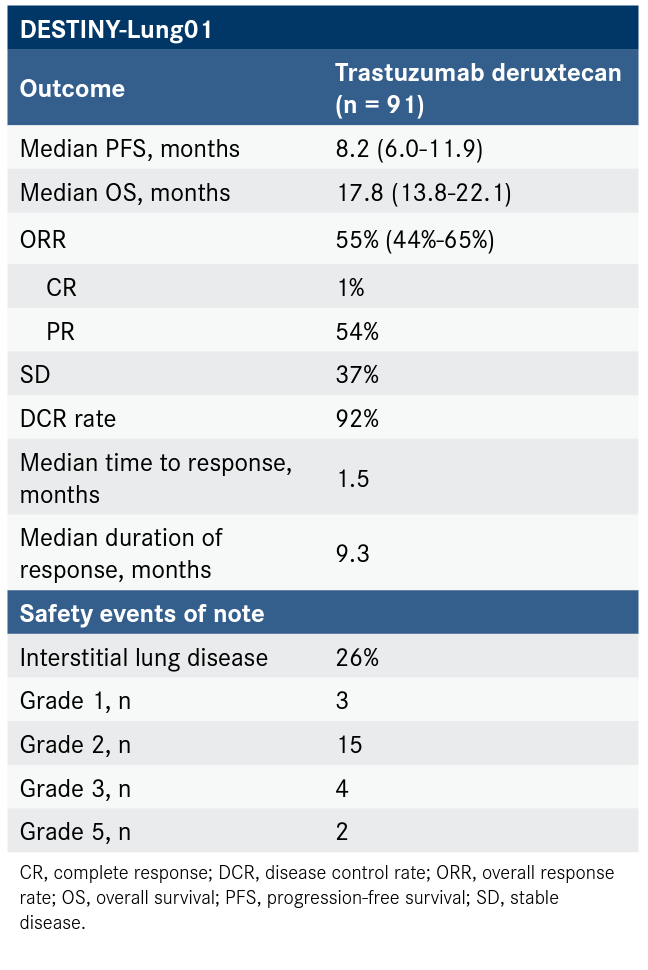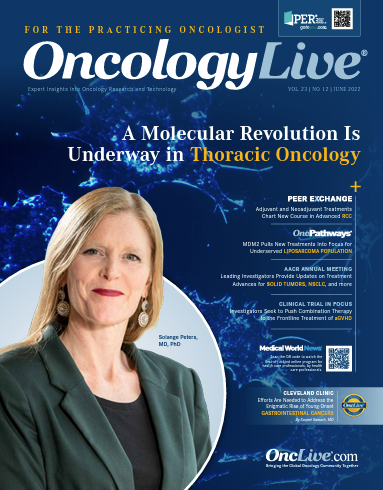Publication
Article
A Molecular Revolution Is Underway in Thoracic Oncology
Author(s):
Targetable alterations including BRAF V600E, EGFR exon 20 insertions, KRAS G12C mutations, MET exon 14 alterations, NTRK and RET rearrangements have taken up recent focus for investigators as data are pushing novel agents through the regulatory processes.
Solange Peters, MD, PhD

The fruits of decades of investigative efforts in thoracic oncology are ripe for picking, according to Solange Peters, MD, PhD. Targetable alterations including BRAF V600E, EGFR exon 20 insertions, KRAS G12C mutations, MET exon 14 alterations, NTRK and RET rearrangements have taken up recent focus for investigators as data are pushing novel agents through the regulatory processes. However, there are several hurdles preventing the translation of these agents into practice including the integration of standardized molecular testing.1,2
In addition to novel therapies illuminating new treatment paths for patients, the success of immunotherapeutic regimens in the metastatic disease has driven investigators to evaluate the applications of the regimens in early-stage resectable disease.3,4
“As the trends move more toward targeted therapies [and we have] agents that are being integrated preresection and postresection, some of the barriers [we need to address are the] issues regarding molecular testing and really integrating that into practice, especially for these patients with early-stage disease,” Peters said in an interview with OncologyLive®. “Immunotherapy also has a large role to play early disease with surgery or any kind of radical treatment. That’s really a revolution.”
As a young investigator, Peters got her start in infectious disease research focusing the topic of her PhD at the Microbiology Institute at the University of Lausanne in Switzerland on the mechanisms of resistance for HIV infection. “If you think about HIV infection and the first treatment, we were [investigating] the clonal divergence of HIV viruses creating resistance. And if you think about my wording it reminds you of cancer, right? How [do we] address something which might kill [an individual] taking into consideration genetic changes over time.” As advances in HIV research plateaued, Peters looked for a way to translate her interest in genetic research to a new field.
“I was working in HIV as a biologist and an MD and, at the time, HIV [infection] was almost under control, I was looking for a field where in the sensitivity of first disease, a second grows, where there is an unmet need in bridging medicine and biology, but also bridging genetics and genetic modifications with treatments. There is no better discipline than oncology,” Peters said. “I immediately found there what I loved in HIV. It’s amazing how [rapidly] the discoveries are now coming, [in particular] looking at genetics.”
Peters has earned a place of prominence among lung cancer investigators and in the oncology area as a whole. She is serving her second year as president of the European Society for Medical Oncology (ESMO). Additionally, Peters is chief of the Medical Oncology Service, an associate professor and chair of Thoracic Oncology, and the chief resident of thoracic malignancies in the Oncology Department at the University Hospital of Lausanne (CHUV) in Switzerland.
Peters is also an active participant in many scientific meetings, including the upcoming 23rd Annual International Lung Cancer Congress® taking place July 28-30, 2022, in Huntington Beach, California. The program, hosted by Physician’s Education Resource® (PER®), LLC, will cover a wide range of topics in thoracic oncology including updates on biomarkers, surgical treatment modalities for resectable disease, and more (Sidebar).
Sidebar.

“I want to know what my colleagues think about the [available] data,” Peters said. “I learn something about the nuance of the data, or the limitations, or maybe something I haven’t thought about. The Congress’ [agenda] is broad, so you do the same exercise [as in other meetings], but in a very comprehensive fashion and this is of tremendous importance.”
Targeted Advances Open the Playing Field
Lung cancer had beginnings in a category of diseases associated with very poor outcomes, Peters noted. “Using the traditional surgery, chemotherapy, and radiation, the outcomes for [patients with] lung cancer have been very, very disappointing for years.” However, as data began to read out from several landmark trials, Peters said that a new story began to unfold in the field in 2 important chapters for thoracic malignancies.
“The first chapter is molecular biology,” Peters said. “We’re trying to understand and discover what are the oncogenes leading to the malignant phenotype. [This research] has led to a wonderful portfolio of targeted therapies.”
This course of molecular discovery kicked off when investigators identified the role of EGFR mutations in non–small cell lung cancer (NSCLC) leading to the introduction of personalized medicine in the field, specifically with the EGFR inhibitor gefitinib (Iressa).2
In the following decade, progress to uncover aggressive mutations accelerated with the identification of 15 mutations that afford patients opportunities for therapy beyond chemotherapy and radiation.
For example, in the past 2 years, treatment options for metastatic NSCLC have risen exponentially with agents including mobocertinib (Exkivity) and amivantamab-vmjw (Rybrevant) for patients with EGFR exon 20 insertions, tepotinib (Tepmetko) and capmatinib (Tabrecta) for patients with MET exon 14 skipping mutations, sotorasib (Lumakras) for patients with KRAS G12C mutations, and lorlatinib (Lorbrena) for patients with ALK-positive disease.5
“From time to time we will discover new compounds or new targets,” Peters said. “I think the low hanging fruits might have been caught by in terms of oncogenes.” Although progress has not stalled in discovery, Peters noted that the focus is now shifting toward improvements in the pharmacology of the agents being developed. “We have been handling more potent drugs, broader drugs in terms of preventing resistance, and very often drugs [developed for metastatic disease], which with lung cancer [can] spread over everywhere in the body, including the brain.”
Peters noted that faced with all progress in molecularly defined disease, testing rates across countries creates limitations in identifying appropriate patients for select therapies. “In Switzerland, [for example], we are very well served, I would say that today every patient with lung cancer can be tapped for the genetic alterations,” Peters said of her home country. “This is not the case elsewhere. Unfortunately, if you look at the picture of molecular testing in Europe, less than half of patients can get access to a decent testing. That’s probably where most advances are needed because it creates unacceptable inequities in the cancer journey.”
Unlocking New Mechanisms of Action
For lung cancer specialists, the plethora of actionable mutations has exploded over the past decade. Most recently, advances in the breast cancer space has opened new options for patients with lung cancer with HER2 amplification.
“This new journey lung cancer specialists are on is because of [discoveries in] breast cancer,” Peters said. In lung cancer, the development of HER2-targeted therapies required looking at the disease in a different light. “We discovered that [in lung cancer] we don’t speak about the same HER2 alteration,” Peters said. “We call amplification, which translates into an overexpression, the quantity. It’s really a modification of the protein.”
Early efforts to identify therapies for patients with HER2-mutant disease—which accounts for approximately 2% of all NSCLC cases—found that translation of select agents deemed successful in breast cancer did not afford the same risk/benefit ratio for patients with lung cancer.6 For example, 18 patients treated ado-trastuzumab emtansine (T-DM1; Kadcyla) in a phase 2 basket trial (NCT02675829) showed that among the overall response rate (ORR) was 44% (95% CI, 22%-69%) with a median progression-free survival (PFS) of 5 months (95% CI, 3.0-9.0).7
“We tried all of these drugs [that were successful in breast cancer], as well as afatinib [Gilotrif], which is a pan-HER inhibitor, in lung cancer, [for patients with] exon 20 insertions,” Peters said. “These compounds have given rise to small activity, [but] if you try to [determine the] risk/ benefit assessment, none of them have really reached the bar which you would consider standard of care.”
However, data from a trial investigating the use of fam-trastuzumab deruxtecan-nxki (Enhertu) has resulted in a breakthrough for patients with HER2-mutant disease, regardless of mutation site.6,8 Data from the DESTINY-Lung01 trial (NCT03505710), which evaluated a total of 91 patients with HER2-mutant NSCLC, demonstrated that the antibody-drug conjugate elicited an objective response rate of 55% (95% CI, 44%-65%), the median duration of which was 9.3 months (95% CI, 5.7-14.7) (Table). Further, the median PFS was 8.2 months (95% CI, 6.0-11.9), and the median overall survival was 17.8 months (95% CI, 13.8-22.1).8
Table. Safety and Efficacy Data from DESTINY-Lung01

“I wouldn’t say there were no options but there was no standard option in HER2-mutant NSCLC,” Peters said. “Suddenly this new generation antibody-drug conjugates have given rise to wonderful results in breast cancer [and now in] lung cancer, where suddenly you reach a threshold where probably with close to 60% response rate. We have gone through these limitations, and we [now] have an option.”
The FDA has accepted for priority review a supplemental biologics license application for trastuzumab deruxtecan for the treatment of adult patients with unresectable or metastatic NSCLC whose tumors have a HER2 mutation and who have received a prior systemic therapy.9
The application is supported by findings from the phase 2 DESTINY-Lung01 as well as data from the phase 1 DS8201-A-J101 trial (NCT02564900). In the phase 1 study, trastuzumab deruxtecan led to an overall response rate (ORR) of 72.7% (n = 8) among 11 patients with HER2-mutant NSCLC.10 The median PFS in these patients was 11.3 months (95% CI, 8.1-14.3).
Regarding the agent’s safety profile, the adverse effects (AEs) observed with trastuzumab deruxtecan in DESTINY-Lung01 were comparable with those reported in prior clinical trials.
The most common grade 3 or higher drug- related, treatment-emergent AEs included neutropenia (18.7%), anemia (9.9%), nausea (8.8%), fatigue (6.6%), leukopenia (4.4%), diarrhea (3.3%), and vomiting (3.3%).9
Twenty-three patients (25%) discontinued treatment because of drug-related, treatment-emergent AEs. Of note, 26% of patients had interstitial lung disease (ILD) or pneumonitis related to treatment per assessment by an independent committee. The majority of ILD events (75%) were low grade (grade 1, 12.5%; grade 2, 62.5%). Additionally, 4 grade 3 (4.4%) and 2 grade 5 (2.2%) ILD or pneumonitis events were reported.
Immunotherapy Carves Out a Role in Early-Stage Disease
The second chapter of the lung cancer revolution is one that Peters refers to as “exciting”: immunotherapy. “Immunotherapy has led to long term survival for some patients in lung cancer despite [having] metastatic disease,” Peters said. “When I started oncology, one could not conceive that the patient with metastatic [disease] would survive years. We now have very strong data showing that immunotherapy should be used alone or in combination in nearly all metastatic patients.”
Peters noted that the refinement of strategies with immunotherapy is an area that will take investigators into the next wave of clinical advances. “Immunotherapies are now moving into early disease. When I say early these are [patients with] small nodules that are resected. These approaches are about combining [immunotherapy] with surgery and curative intent treatments. How can you make surgery more efficient in creating cure?”
Data for patients with early-stage disease have generated excitement including data from the phase 3 CheckMate 816 trial (NCT02998528). Investigators compared nivolumab (Opdivo) plus chemotherapy with chemotherapy alone for treatment of patients with resectable NSCLC.11 The median eventfree survival (EFS) was 31.6 months in the nivolumab plus chemotherapy arm vs 20.8 months in the control arm (HR, 0.63; 97.38%, 0.43-0.91). The 1-year EFS rate was 76% in the experimental arm and 63% in the control; the 2-year EFS was 64% vs 45%, respectively.11
These data supported the approval of the combination, making it the first approval for patients in the neoadjuvant setting for patients with NSCLC in March 2022.12
In terms of adjuvant therapy for earlystage disease, data from the IMpower010 study, supported the approval of atezolizumab (Tecentriq) for patients with stage II-IIIA NSCLC whose tumors have PD-L1 expression of at least 1%.13
The primary end point was disease-free survival (DFS). Among patients who received atezolizumab the median DFS was not reached (95% CI, 36.1-not estimable [NE]) vs 35.3 months (95% CI, 29.0-NE) with best supportive care (HR, 0.66; 95% CI, 0.50-0.88; P = .004).
Investigators also assessed patients with PD-L1 expression of at least 50%, among whom the DFS benefit was more pronounced with atezolizumab compared with best supportive care (HR, 0.43; 95% CI, 0.27-0.68). However, an exploratory subgroup analysis of patients with PD-L1 expression 1%-49% the DFS benefit was less pronounced (HR 0.87; 95% CI, 0.60-1.26).
“We are seeing the first data from these trials already,” Peters said, noting that the road for determining optimal treatment strategies for patients is a long one. “In the [next several] years there will be way more trials in early disease,” Peters said.
The Road Ahead
Peters remains hopeful about the future of the space, as it moves toward integration of molecular testing strategies and opening up new and potentially curable avenues for patients with thoracic cancers. Within that pipeline she noted that prevention strategies that may shift the curve in terms of disease incidence.
“We need to do more screening for lung cancer and we need to start to implement programs for heavy smokers, [which incorporate] regular CT scans,” Peters said adding that with these efforts to improve the identification of early-stage disease coupled with improvements in the landscape would be a step toward curable disease.
“I think what is really for us, something which really makes us feel differently as being lung cancer clinic and, is this new [direction of the] field—trying to cure more patients,” Peters said. “That’s maybe what differentiates us a lot from breast cancer specialists. When breast cancer specialists treat with chemotherapy and hormonal therapy, as well as surgery, they get to cure individuals, the [survival] curves in breast cancer can be very, very high between 80% and 100%. In lung cancer, when you perform surgery, and maybe [administer] chemotherapy for patients, only half of the patients will be cured, or even less, maybe 40%. Even with all the lung specialists, we still [making efforts to] cure the disease.”
On a more personal note, Peters said that although being on the ground floor of breakthrough research are moments in a career that standout, her attention is now on the future successes of her fellows and mentees. “My proudest moments now are to have one of my young fellows or mentees being recognized for something he or she has done,” Peters said.
She noted that in preparing the next generation of investigators mentorship is of the utmost importance. “I was carried by wonderful mentors,” Peters said. “A mentor is someone who will put you on the scene, give your name to give a talk.”
In addition to promoting early and lasting relationships among physician scientists, Peters said that promoting the interprofessional dimension of cancer care is one of the items that she placed a focus on as the president of ESMO. “The medical oncologist cannot work alone, everything has become multiprofessional—molecular pathologists, the surgeons the radiologists, and so on—we need to understand that these data have to go through all these layers [to convey information.”
Broadening the scope of conveying information, Peters spearheaded the creation of the International Cancer Foundation (ICF) at ESMO.14 The ICF aims to provide educational activities to clinicians in areas that are underserved, opening the expansion of knowledge of advances in cancer to the world.
“We’re doing the same thing we do in ESMO, but translating into a visibility concept, which can be also used in Africa, in South and Central America, and in all countries of India, for example,” Peters said. “We realized that ESMO is in a position to reach out to them and address their specific needs and concerns. The ICF aims to support, financially and practically, activities that enhance cancer prevention, diagnosis, treatment and follow-up where they are most needed. If we can give a little bit of our energy to help the [clinicians who may be] a little bit delayed in receiving these data], it would be a good move.”
References
- Tan AC, Tan DSW. Targeted therapies for lung cancer patients with oncogenic driver molecular alterations. J Clin Oncol. 2022;40(6):611-625. doi:10.1200/JCO.21.01626
- Russo A, Franchina T, Ricciardi GRR, et al. A decade of EGFR inhibition in EGFR-mutated non small cell lung cancer (NSCLC): old successes and future perspectives. Oncotarget. 2015;6(29):26814-26825. doi:10.18632/oncotarget.4254
- Chaft JE, Shyr Y, Sepesi B, Forde PM. Preoperative and postoperative systemic therapy for operable non-small-cell lung cancer. J Clin Oncol. 2022;40(6):546-555. doi:10.1200/JCO.21.01589
- Linehan A, Forde PM. Moving immunotherapy into early-stage lung cancer. Cancer J. 2020;26(6):543-547. doi:10.1097/PPO.0000000000000493
- Oncology (cancer) / hematologic malignancies approval notifications. FDA. Updated May 31, 2022. Accessed June 5, 2022. bit.ly/3qpecqn
- Passaro A, Peters S. Targeting HER2-mutant NSCLC - the light is on. N Engl J Med. 2022;386(3):286-289. doi:10.1056/NEJMe2119442
- Li BT, Shen R, Buonocore D, et al. Ado-trastuzumab emtansine for patients with HER2-mutant lung cancers: results from a phase II basket trial. J Clin Oncol. 2018;36(24):2532-2537. doi:10.1200/JCO.2018.77.9777
- Li BT, Smit EF, Goto Y, et al; DESTINY-Lung01 Trial Investigators. Trastuzumab deruxtecan in HER2-mutant non-small-cell lung cancer. N Engl J Med. 2022;386(3):241-251. doi:10.1056/NEJMoa2112431
- Enhertu granted priority review in the U.S. for patients with previously treated HER2 mutant metastatic non-small cell lung cancer. News release. Daiichi Sankyo. April 19, 2022. Accessed June 4, 2022. bit.ly/3rAE1mS
- Tsurutani J, Iwata H, Krop I, et al. Targeting HER2 with trastuzumab deruxtecan: a dose-expansion, phase I study in multiple advanced solid tumors. Cancer Discov. 2020;10(5):688-701. doi:10.1158/2159-8290.CD-19-1014
- Forde PM, Spicer J, Lu S, et al; CheckMate 816 Investigators. Neoadjuvant nivolumab plus chemotherapy in resectable lung cancer. N Engl J Med. 2022;386(21):1973-1985. doi:10.1056/NEJMoa2202170
- FDA approves neoadjuvant nivolumab and platinum-doublet chemotherapy for early-stage non-small cell lung cancer. FDA. March 4, 2022. Accessed June 5, 2022. bit.ly/3b36vQM
- FDA approves atezolizumab as adjuvant treatment for non-small cell lung cancer. FDA. October 15, 2021. Accessed June 5, 2022. bit.ly/3b9jhdp
- The International Cancer Foundation: ESMO’s tangible commitment towards equity in cancer care. European Society for Medical Oncology. December 12, 2021. Accessed June 5, 2022. bit.ly/3HG1ARX









